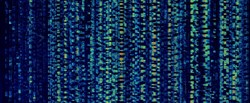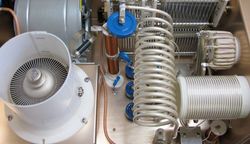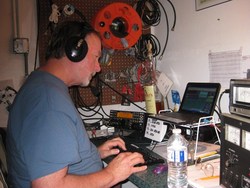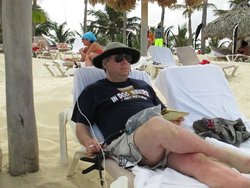 March 13, 2013 Editor: Ward Silver, NØAX | |||||||
IN THIS ISSUE
NEW HF OPERATORS - THINGS TO DO The Russian DX Contest is rapidly growing due to good participation and excellent log-checking and judging. Why not aim your ears to over the North Pole and see what you can work? Digital mode enthusiasts find the British Amateur Radio Teleprinter Group's series of contests to be great fun, as well. BULLETINS There are no bulletins in this issue. BUSTED QSOS No busted QSOs reduced my score in the past issue! CONTEST SUMMARY Complete information for all contests follows the Conversation section March 16-17
March 23-24
Hamfest Happenings The famed Friedrichshafen hamfest, properly known as the "Ham Radio 2013 Convention" will take place from Friday, June 28 through Sunday, June 30. Join 15,000 other visitors from around the world in this second largest of all ham radio gatherings! Tickets for the Friday evening Contest Dinner at the International DX Convention in Visalia are now available for purchase. Unlike previous years, no walk-up tickets will be available. None. Nada. Zip. As dinner organizer, Jeff WK6I suggests, "Please plan ahead!!!" Dayton Dead Ahead! All of the details on the 2013 Hamvention Antenna Forum and many more for 2013 are now posted online for your planning purposes. Contesting related events for all four days are posted, too. (Thanks, Tim K3LR) Activity on the contesting.com Contest wiki seems to have expired. Nevertheless, the CQ World Wide Contest web site is actively maintained and includes a list of contest clubs. Make sure your club's information is in the list - maybe there is a contester near you that needs a club! (Thanks, Randy K5ZD and Pete N4ZR) On January 24th, the United States Naval Academy Alumni Association announced that Scott Redd, KØDQ will be recognized with the 2013 Distinguished Graduate Award during a medal presentation ceremony on March 22 at the United States Naval Academy in Annapolis. You may also recognize Scott's U.S. Navy colleague, Ed N4OC in the video. Watch for more on KØDQ in an upcoming issue of the National Contest Journal. (Thanks, NCJ Editor, Kirk K4RO and Doug K1DG) How do they do it? Here is an interesting blog on catching contest cheaters in the CQ Worldwide contest. (Thanks, Daily DX) For those of you suffering from post-pileup depression, you might benefit from the Onion-esque story Man Depressed Months After Contest Ends on the Ham Hijinks page of the Noise Blankers Radio Group website. Who shut down the Super Bowl? All explained here. (Thanks, Kevin K5KVN)
Best pre-contest announcement ever - "four ops, maybe five if Dave's defendant pleads out at trial and he gets to the station in time." After every contest, what could be more fun than hearing the sad tales of woe from friends and foes alike - especially foes. And sharing yours, too! The Mt. Airy VHF Radio Club - better known as the Packrats - has formalized this great tradition in their Cheese Bits newsletter's "Crying Towel" feature. Great reading no matter which end of the towel you're on! AMSAT is now preparing for two launch opportunities under the NASA Cubesat Launch Initiative. This is a great example of the STEM (Science, Technology, Engineering, and Mathematics) training ham radio can provide to students and faculty alike. Hams pioneered the Cubesat concept - now the most-launched type of satellite! The AMSAT engineering team expects to complete the satellites Fox-1 in 2013 and have RadFxSat ready in the 2nd half of 2014. Both are designed with U/V-mode FM analog transponders, workable with dual-band handheld radios and hand-held "Arrow" antennas. Lots more technology will be aboard, of course, check out the AMSAT web site for more information. (From AMSAT bulletin ANS-069)
How can you tell if a contest is right for you? The Potomac Valley Radio Club conquers this conundrum with a clever calculation. (Thanks, John K3TN) The movie "Lincoln" featured true-to-life telegraphy at various critical points throughout, leading many to wonder whether the depiction was really accurate or not. The article "NOW STARRING ...TELEGRAPHY!" by James Wades WB8SIW published in the March issue of the Potomac Valley Radio Club newsletter goes into some detail about the movie's depiction of our Morse progenitors. Web Site of the Week - With sprint contests gaining in popularity right and left, the schedule for the 2013 Spring VHF+ Sprints has been released:
Get on for these short events and have fun! (Thanks, Darryl WW7D) WORD TO THE WISE Read the rules FIRST! In a 24 March webinar, CQ Contest Director Randy K5ZD will provide an overview of the rule changes for the upcoming CQ WPX 2013 contests and will answer questions from the audience. (Thanks, Ken K4ZW) In memory of Gene Zimmerman W3ZZ, the Delmarva VHF and Microwave Society (DVMS), K8GP and the Grid Pirates Contest Group (GPCG) are republishing a webinar given by Gene on VHF Contesting - "What To Do and How To Win". The presentation, originally given in 2010, is about 90 minutes long and covers station siting, station design, station integration, winning strategies, digital modes and the ideal stations. (Thanks, Chuck W4XP)
The open house tours of W3LPL are legendary but if Maryland is just a bit too far away for you to attend, Frank has provided this video tour of his station. Don't miss Frank's Mar 18th webinar on the 1921 Transatlantic Tests! And speaking of satellites as in the news section, just how DO you build one, anyway? This BBC video "How To Build a Satellite" explains the basics - now get ready for launch! (Thanks, Bryce KB1LQC) "My old man's a radio 'am" - no, it's not Herman's Hermits with a remake of "Henry the Eighth" but a brand-new original song about GJ2A's ham radio adventures. (Thanks, Tim K3LR) What did Bill Nye the Science Guy do before he was famous? He was a real-life engineer and local TV comic personality in Seattle, writing and performing in skits like this spoof horror episode of "Date With An Engineer" on the KING-TV "Almost Live" show. Official results have been recently posted for two more WRTC-2014 qualifying events and the updated WRTC-2014 Event Scores are now posted online. Results from the 2012 All Asian DX CW and SSB contests have been applied and several scores were adjusted or reassigned. Eight qualifying events have taken place for which official results are not yet available. Many Selection Area races are coming down to the wire as ARRL DX Phone was the last qualifying event! Look for the focus to switch to determining the Team Leaders, their Team Mates, and the pool of Referees. Just over 16 months are left until WRTC-2014! (Thanks, WRTC-2014 Team Selection Director, Dan K1TO) Your ARRL DX Contest writeup authors would like to hear about your experiences in the recent contests. Do you have an exciting story, a tale of woe, or just good times? Large, medium, and small - it makes no difference 'cause we love them all! Send your material to Rick WW1ME (ARRL DX CW) or your editor (ARRL DX Phone) and be sure to post your photos on the ARRL Soapbox page, as well! The results of the 2012 CQ VHF contest have been posted online and are also in the winter issue of CQ VHF Magazine (this year only). The 2013 contest results will be back in CQ next year. (Thanks, CQ VHF Contest Director, Steve N8BJQ)
The LQP (Locust QSO Party) results are now available. The Locust (a.k.a. Rick K6VVA) extends his congratulations to all the Category Winner entrants who will each receive a one year National Contest Journal subscription or renewal. While the contests are never over until the log checkers say they're over, it sure looks like the K3LR teams have pulled off a sweep of the Big Four - CQ WW CW & SSB and ARRL DX CW & Phone. A sweep has been accomplished seven times, the last having been in the 2002/2003 contest season by the KC1XX team. Are there similar accomplishments from the DX side? Here's an update on some serious DX - The long-distance low power record is held by KL7YU and W7BVV using one micro-watt on 28 MHz over a distance of 1,650 miles between Alaska and Oregon in 1970 - According to Rich Arland, K7YHA (now K7SZ), in WorldRadio magazine (Feb. 1990, pp. 46-47.) 1.6 billion miles per watt! (Thanks, Mark K6UFO) OPERATING TIP Be prepared - run through a station checklist well before the contest, including for the operator! Then be ready for problems during the contest because Murphy is never far away. Multi-operator station hosts know this well - sometimes there are repairs that have to be done during the race! K3LR had ring rotators freeze up with icing during ARRL DX Phone - the rotators were freed with torches on the tower at midnight - three times during the weekend, in fact! Every big station host deserves a tip of the contester's cap in recognition of and appreciation for what keeps those state-of-the-art signals sounding so superb. HFTA author Dean Straw N6BV writes to let us know, "Sometime in the last few month USGS has greatly changed their NED "Seamless" data site, requiring the instructions for finding and downloading terrain data to be re-written in HFTA.pdf. The new data site is called the "National Map."" Dean has updated the instructions for HFTA in a new PDF file available for download at in the Supplemental Information and Tools area of the ARRL Antenna Book website. Tom KD8DEG, an experienced cable-puller, suggests that when pulling multiple cables through conduit, stagger the leading ends of the cables by five to seven inches. That avoids trying to get all of the cable ends through a sweep (use sweeps and not elbows) at once. For lubrication, he endorses the Polywater line of products, leaving no residue and widely carried by electrical supply houses. And Gene AD3F reminds us to "Leave a pulling rope inside the conduit for (inevitable) future installs. You can install this rope along with the last coax pull."
Looking for cheap LEDs? You can "repurpose" the strings of solid and mixed color of LEDs available for a few dollars from department stores. Depending on the manufacturer, they may have from 50-100 LEDs. (Thanks, Kurt KD7JYK) Speaking of LEDs, here's a great lighting ring design to help you see clearly on the workbench when using a drill or grinding tool. Whither Cycle 24? It's the cycle that just doesn't seem like it will ever get into high gear. NASA weighs in with the story "A Quiet Interlude in Solar Max" on the interesting Earth Observatory website. Much is made of technical literacy - here's an example of a web site promoting software literacy for kids growing up in a largely software-driven world. I can think of other examples of critical technologies that are little understood but on which a great deal of modern life depends - such as electricity and wireless technologies. (Thanks, Jim K9JF) If you've ever worked with a crane, it's critical to have an accurate distance measurement from where the crane will set up to where the load is going. In the past you'd have to climb roofs or sometimes estimate blind distances and hope your estimate is a good one. Due to the amazing abilities of smartphones, Steve K7LXC reports that the days of guesstimates are over. His crane operator used an Android app called Map Ruler to quickly get an accurate distance between a tower base and the crane location. It works for all kinds of site planning or measurement. These are examples of what is known as a "theodolite app" - some use a camera shot and some require sighting along an edge of the phone. They're not a replacement for the more accurate surveying equipment but for most amateur uses, they offer plenty of precision. (Thanks also to Jim W6RMK) More on satellites, Mike DK3WN has produced a summary of all active amateur radio satellites with frequencies and links to more detailed information. (From AMSAT bulletin ANS-069) Technical Web Site of the Week - Watt's In a Name? Some time ago, Roy W7EL published an insightful perspective on "RMS Power" on his website. Hint, this term doesn't have much meaning although it is widely used. (Thanks, Paul W9AC) The RBN...and You Following the ARRL DX CW contest, there was a lot of online discussion about the perceived quality of spotting information generated by CW Skimmers operating around the world and relayed to the world-wide spotting networks. While the information may not have been any worse than the usual human-generated false data, its volume made it more noticeable. Since many Skimmer-generated spots came through the Reverse Beacon Network, I offered this space to RBN leader, Pete N4ZR, to discuss the issue. 73, Ward NØAX I'm delighted to be a guest writer for this issue because of the large audience of exactly the folks I hope to reach. Let me begin by clarifying a little of what the RBN is and how it works. The spots forwarded by the RBN are collected by over 200 volunteer "Skimmers" worldwide. Each "beacon" is set up and paid for by individuals, and their setups range from simple single-band Softrocks to the sophisticated 7-bands-at-once QS1R, used by some 60 of our most active contributors. Antennas are anything from simple dipoles to the massive antenna farms at W3LPL and K3LR. Throughout its lifetime, the RBN has functioned basically as a "mother ship", collecting all of these spots and redistributing them through two Telnet nodes, which in turn provide them to hundreds of DX cluster nodes worldwide. We also provide raw data for research and tools for comparing signals, but spots are our main line of business.
We're very concerned about the quality of the spots we provide. Each "Skimmer" is constantly being told how well the frequencies being reported compare with reference stations. When we notice (or are told about) stations with problems, we go to work with them to deal with the problem. After the ARRL DX CW contest, for example, we noticed that a couple of prolific Skimmers had image problems - the same station spotted simultaneously on two frequencies. We worked with the owners to resolve those problems quickly, and the RBN will be the better for it. But what about busted spots? Well, under ideal conditions, I believe the Skimmer software's decoding is probably more than 99.9 percent accurate, far better than human spotters. But when you have 100+ Skimmers, operating under far from perfect circumstances, all contributing spots to a common stream which is forwarding around 2 million spots in a 24-hour period, there will be a fair amount of junk. We confronted this early on, and decided to rely on users constructing their own filters - more to come on this. We're currently evaluating whether this policy can be successful and may decide to make two streams available - one filtered and the other raw. Okay, on to the "you" part. As a user of RBN spots, a lot of the raw stream will be unusable - what do you care what someone on the other side of the planet is hearing? A few of the big multis will want to see everything and do their own filtering, but for the rest of us, limiting the spots you see to those you can probably hear makes sense. I use a node that has AR Cluster Version 6 software installed, and can easily limit spots to those from Skimmers in the states surrounding my QTH. AR also has a very handy filter ("Unique>x") that only reports spots that meet your other conditions and have been heard by more than "x" Skimmers world-wide. Use a combination of these filters and you will virtually eliminate busted spots, even late in the contest when you've worked the bands dry of run stations. For a contester who wants to be spotted often and correctly, here are a few simple suggestions. The use of the keywords "CQ" and "Test" has already been discussed at length elsewhere, but remains critical. You can even use this knowledge to reduce the size of your pileups, by omitting the keywords sometimes, using them at others. Whatever you do, send everything at the same speed, and be sure to use correct spacing - if you send N4ZRTEST instead of N4ZR TEST, or send the "TEST" 15 wpm faster, you'll deserve what you get, or don't. If your call sign is unusual, in length or makeup of the prefix, you may need to send your call sign two or more times during each CQ - this is because CW Skimmer uses a table of prefixes and suffix lengths to determine how "picky" to be about what it copies - an odd call takes more validation before it is accepted. One thing that affects both users and Skimmers is the various sources of spurious signals. If you are operating and Skimming at the same time, you'll need to disable your Skimmer receiver during transmit, or it will spot all sorts of weird variations of your call sign because of overload. If you want to be spotted on your actual frequency, make sure that your signal is free of key clicks and harmonics. That's pretty much the whole story. I hope it's helpful. 13 March through 26 March An expanded, downloadable version of QST's Contest Corral in PDF format is available. Check the sponsor's Web site for information on operating time restrictions and other instructions. HF CONTESTS North American Sprint--Phone, from Mar 17, 0000Z to Mar 17, 0400Z. Bands (MHz): 3.5-14. Exchange: Both call signs, serial, name, and S/P/C. Logs due: 7 days. Rules CWops Monthly Mini-CWT Test--CW, from Mar 13, 1100Z to Mar 14, 0400Z. Multiple operating periods, twice monthly on 2nd and 4th Wed. Bands (MHz): 1.8-28. Frequencies: 18 to 28 kHz above band edge. Exchange: Name and member number or S/P/C. Logs due: 2 days. Rules Feld-Hell St Patrick's Day Sprint--Digital, from Mar 16, 12 PM to Mar 16, 2 PM. Monthly on 3rd Saturday. Bands (MHz): 1.8-28. Exchange: RST, S/P/C, Feld-Hell member nr. Logs due: 7 days. Rules BARTG HF RTTY Contest--Digital, from Mar 16, 0200Z to Mar 18, 0200Z. Bands (MHz): 3.5-28. Exchange: 3-digit serial and 4-digit time. Logs due: May 1. Rules Russian DX Contest--Phone,CW, from Mar 16, 1200Z to Mar 17, 1200Z. Bands (MHz): 1.8-28. Exchange: RS(T), serial or oblast abbr. Logs due: See web. Rules Oklahoma QSO Party--Phone,CW,Digital, from Mar 16, 1300Z to Mar 17, 0200Z. Multiple operating periods. Bands (MHz): 3.5-28, 50, Frequencies: CW 35 kHz above band edge; Phone 3.860, 7.195, 14.260, 21.335, 28.470, 50.130 MHz. Exchange: RS(T) and OK county or S/P/"DX". Logs due: Apr 30. Rules Virginia QSO Party--Phone,CW,Digital, from Mar 16, 1400Z to Mar 17, 0200Z. Bands (MHz): 1.8-28, 50-440, Frequencies (MHz): CW 1.805, 50 kHz+ band edge; Phone 1.845,3.86,7.26,14.27,21.37,28.37; 50.130, clg freq 144/220/440. Exchange: Serial and VA county/city or S/P or "DX". Logs due: Apr 15. Rules QCWA Spring QSO Party--Phone,CW,Digital, from Mar 16, 1800Z to Mar 16, 1800Z . Bands (MHz): 1.8-28, 50+. Exchange: Call,year lic'd,name,QCWA chap or S/P/C. Logs due: 30 days. Rules Run For the Bacon--CW, from Mar 18, 0200Z to Mar 18, 0400Z. Monthly on 3rd Sunday night (local). Bands (MHz): 1.8-28. Exchange: RST, S/P/C, Flying Pig nr or power. Rules CLARA and Family HF Contest--Phone,CW, from Mar 19, 1700Z to Mar 24, 1700Z. Multiple operating periods. Bands (MHz): 3.5-28. Frequencies (MHz): CW 3.688, 7.033, 14.033, 21.033; Phone 3.750, 3.900, 7.033, 7.200, 14.120-130, 14.288, 21.288, 28.488 MHz . Exchange: RS(T), name, QTH, and if CLARA mbr. Logs due: Apr 15. Rules NAQCC Monthly QRP Sprint--CW, from Mar 21, 0030Z to Mar 21, 0230Z. Monthly on 2nd Tuesday or 3rd Wednesday local time (alternating). Bands (MHz): 3.5-14. Exchange: RST, S/P/C, and NAQCC mbr nr or power. Logs due: 4 days. Rules FOC QSO Party--CW, from Mar 23, 0000Z to Mar 23, 2359Z. Bands (MHz): 1.8-28, 50+. Exchange: RST, name, FOC nr if member. Logs due: 7 days. Rules Lighthouse Spring Lites QSO Party--Phone,CW,Digital, from Mar 23, 0001Z to Mar 30, 2359Z. Bands (MHz): 1.8-28. Exchange: ARLHS number or serial, name, S/P/C. Logs due: 12 days. Rules Alaska QSO Party--Phone,CW,Digital, from Mar 23, 1800Z to Mar 24, 2359Z. Bands (MHz): 1.8-28. Exchange: Serial, call sign, first name, 4-char grid square. Logs due: 2 weeks. Rules VHF+ CONTESTS Worldwide EME Contest--Phone,CW, from Mar 16, 0000Z to Mar 17, 2400Z. Bands (MHz): 144, 432. Exchange: TMO/RS(T) and "R". Logs due: Jul 14. Rules Oklahoma QSO Party--Phone,CW,Digital, from Mar 16, 1300Z to Mar 17, 0200Z. Multiple operating periods. Bands (MHz): 3.5-28, 50, Frequencies: CW 35 kHz above band edge; Phone 3.860, 7.195, 14.260, 21.335, 28.470, 50.130 MHz. Exchange: RS(T) and OK county or S/P/"DX". Logs due: Apr 30. Rules Virginia QSO Party--Phone,CW,Digital, from Mar 16, 1400Z to Mar 17, 0200Z. Bands (MHz): 1.8-28, 50-440, Frequencies (MHz): CW 1.805, 50 kHz+ band edge; Phone 1.845,3.86,7.26,14.27,21.37,28.37; 50.130, clg freq 144/220/440. Exchange: Serial and VA county/city or S/P or "DX". Logs due: Apr 15. Rules QCWA Spring QSO Party--Phone,CW,Digital, from Mar 16, 1800Z to Mar 16, 1800Z . Bands (MHz): 1.8-28, 50+. Exchange: Call,year lic'd,name,QCWA chap or S/P/C. Logs due: 30 days. Rules FOC QSO Party--CW, from Mar 23, 0000Z to Mar 23, 2359Z. Bands (MHz): 1.8-28, 50+. Exchange: RST, name, FOC nr if member. Logs due: 7 days. Rules LOG DUE DATES 13 March through 26 March
ARRL Information Click here to advertise in this newsletter, space subject to availability. Your One-Stop Resource for Amateur Radio News and Information ARRL membership includes QST, Amateur Radio's most popular and informative journal, delivered to your mailbox each month. Subscribe to NCJ - the National Contest Journal. Published bimonthly, features articles by top contesters, letters, hints, statistics, scores, NA Sprint and QSO Parties. Subscribe to QEX - A Forum for Communications Experimenters. Published bimonthly, features technical articles, construction projects, columns and other items of interest to radio amateurs and communications professionals. Free of charge to ARRL members: Subscribe to The ARRL Letter (weekly digest of news and information), the ARES E-Letter (monthly public service and emergency communications news), Division and Section news -- and much more! ARRL offers a wide array of products to enhance your enjoyment of Amateur Radio. Visit the site often for new publications, specials and sales. Donate to the fund of your choice -- support programs not funded by member dues! Reprint permission can be obtained by sending email to permission@arrl.org with a description of the material and the reprint publication. ACKNOWLEDGEMENTS ARRL Contest Update wishes to acknowledge information from WA7BNM's Contest Calendar and SM3CER's Contest Calendar. | |||||||












